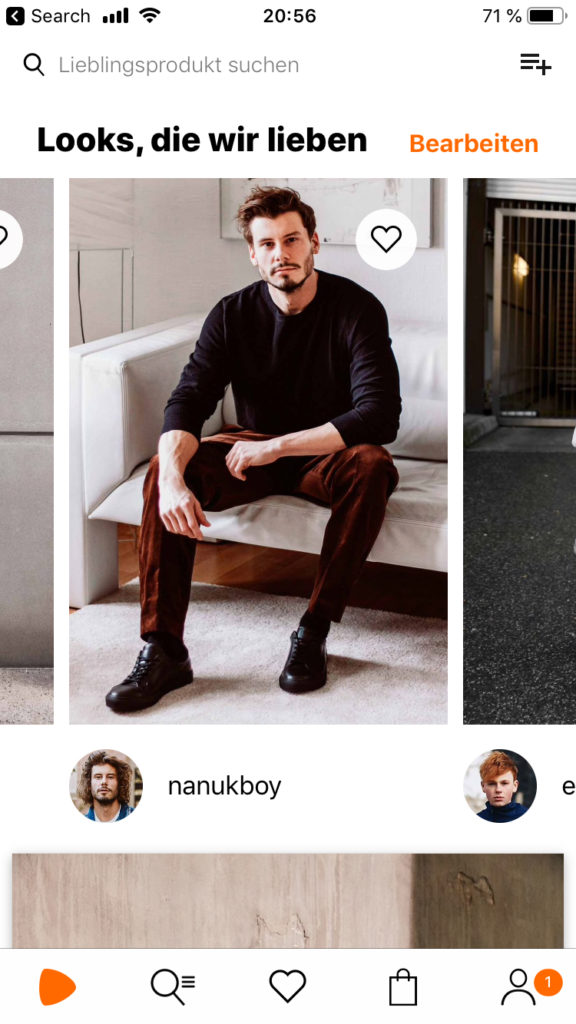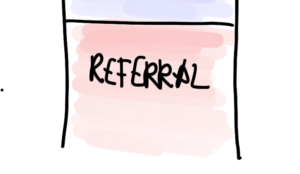So far we have talked about the responsibilities of a Product Manager and how to find Product/Market fit. We have seen the „product perspective“ as a rather narrow concept: Thinking, how the product should look like to attract an audience and to be useful. In this article we will expand this concept by taking a look at the product growth cycle.
A product is more than „just“ a useful asset. Think of Red Bull versus a normal energy drink. Ingredient-wise they are the same thing: soda water, sugar, caffeine, aroma.
But drinking Red Bull makes you feel special. The product is more than just the drink, it‘s an experience. Why is that?
It is, because great marketing creates a certain feeling inside a customer.
Great brands build emotions.
This article is about the marketing side of product management and how to strategically go about this.
The Growth Funnel
How a customer feels while using your product and how he perceives the value that a product is providing can be assessed via a concept called „user journey“.
Dave McClure from 500 Startups is famous for the following model, that describes the journey of a user in a product. Users move from top of the funnel to bottom of the funnel while at each stage some users will drop off. As a Product Manager you are concerned about those drop off rates. How to go about this will be topic of a later post.

Acquisition

Acquisition covers anything that brings the user to your product. Naturally this is where the group of potential customers is the largest, slowly dropping off while moving through the funnel.
This is where good product design starts: Marketing is concerned with the outside communication of your product, while as a PM you are mainly concerned about understanding where the user comes from, how he is feeling, and how to emotionally address him in the best way possible.
Positioning
Understanding how your product is positioned on the marketplace is the first step to get an understanding of a potential new customer. Why?
For example it makes a tremendous difference whether it’s promoted for the mass market or for a professional audience.
This impacts the later product design in major ways: Can you use jargon or do you need to explain things? Or, do you want to sound motivational/pushy because your users need to stick with a certain routine?
Plus, you want to have an idea about your competition’s positioning relative to yours. Products compete for certain user groups and usually communicating well with those is one of the keys to winning the battle.
As a PM, you want to be empathetic with your users. You want to know their social status, demographics, income,… everything that contributes to make the product more useful for him. You want to understand how he discovered your product and his emotional state.
Essentially, you want to communicate with him in a way that helps him in this exact context.
Expectations
A Product Manager needs to understand what a user expects from a product, which is usually related to how it is marketed. Coming back to my example from before: Red Bull understands very well that customers expect extraordinary excitement, confidence, and a little craziness from their product.
You wouldn’t be able to fulfill those expectations with orange juice. The artificial taste, the caffeine that makes your heart rate go up and the image of a party drink when mixed with vodka – that all is part of the Red Bull product.
On a related note: as soon as a certain image is built, it turns into a self fulfilling prophecy (at least if you don‘t make any major mistakes). This is called the „Pygmalion Effect“. Eg. I would assume that people still think of Amazon as a customer centric company although prices for Prime are rising, delivery times are increasing or there is a scandal about Alexa recording private conversations.
Storefront
After the user has decided for your product, it matters a great deal where he is able to get it: It is no coincidence that Red Bull has specially branded fridges or Apple has super futuristic stores. How the product is presented contributes to the customer’s feeling when going for the product.
I’m avoiding the term „buying“ the product consciously here. The price of the product is of course also part of the „message“ that is perceived by the customer.
In the digital world, products are often downloaded via app stores. I like to think of the App Store design as a storefront as well. The images and wording that are used have the same impact as the Red Bull fridges and the Apple stores. Therefore Product Managers have to pay attention to optimize those assets while building the image of the product.
Sources of Acquisition
Lastly, I want to talk about acquisition sources. That are the channels where the user discovers your product and is referred to your storefront. In B2C companies there often is a growth team that is in charge of designing and executing campaigns eg on social media. As a PM you want to understand those and their core message. You can tailor the app’s content around them to streamline the experience and enhance the product design.
Engagement

As soon as your customer has acquired the product it‘s all about making him engage with it. I covered a lot of those ideas with the product perspective in previous posts: The user needs to understand how it works and what to use it for. Like the hammer, that looks like a hammer, feels like a hammer, and does the things we expect a hammer to do. Just pick it up and put your nails into the wall.
Especially in the digital space, where products sometimes have a lot of features, this can be get quite tricky. The concept of „onboarding“ – explaining how to use a product – is often discussed between PMs and user interface designers.

Some argue, that a truly good design does not need any explanation because the explanation interrupts the product experience. It’s like putting a post-it on the hammer’s grip with the words „Pick me up here“.
On the other hand – so the argument goes – products are sometimes so powerful, that features need explanation on how to be used.
This makes sense intuitively: You are talking to your grandmother differently about the internet than to your 15 year old niece, who grew up with technology.
From my experience both arguments are true to a certain degree. What needs consideration is, what I was explaining in previous paragraphs: Where does the user come from? Who is he? And especially in this case: How savvy is he with technology?
Monetization

If the topic of engagement was covering the product perspective, monetization is mainly covering the business perspective. How your product makes money is one of the most critical and complex product decisions there is.
You could have a free product, that monetizes with ads (eg. Facebook), you could have a paid and a free version of your product (freemium), you could have a subscription model, you can have micro transactions (such as games) or you could be selling products through your app (e-commerce).
Each of those monetization models have different pros and cons and each fit a different type of business. There is extensive literature about all of those types, so I will try to give a short overview on the product decisions that come with certain models.
Ads
Ad driven businesses are typically very data hungry. Because the more you know about a user, the better he can be targeted and the more likely he is to convert on an ad. Facebook and Google have kind of a monopoly in the digital ad space because they know most about their users already.
Product Managers in those companies always have to take into account, that the features they are designing are contributing to their user‘s data profiles. For example, when Google asks you about your areas of interest for news, they will use this data to feed their algorithm and suggest according products to you later on.
This is exactly how ad driven companies work: design useful features and use the generated data to optimize (ad) content.
Freemium
In the early days of software, almost all products offered a limited free version for trial that could later be purchased to unlock the full version. Major updates were shipped in cycles and were usually paid for, so each year you could buy a CD with the new version of MS Office.
This model is dying, mainly because updates are delivered on the fly and no one is willing to pay for them anymore. And this is also the case why I will cut this topic short here and focus more on…
Subscriptions
Subscriptions are currently the state of the art monetization model – both in B2B and in B2C. Because of my background in B2C I will focus my observations on this side of business.
Almost every company is currently trying to set up some kind of subscription business. I believe I could write an own article about subscriptions. To get started I want give a short overview of what I find the most import success criteria:
- Extensive value: arguably, the most successful subscription services offer an unbelievable amount of services and content. Consider Netflix (thousands of movies and series), Amazon (everything from Prime delivery, Whole foods, Content,…) or Spotify.
- Great product design: Those companies focus extensively on providing an amazing product experience to their paying customers: Same day delivery, personalized recommendations, original content,…
- Ongoing customer engagement: Subscription businesses have to extensively focus on letting the customer feel, that they get value provided for what they are paying for. This goes so far, that cheap gym chains offer free barbecues to their customers once a week.
So, why are subscriptions so interesting to businesses?
The main reason is, that subscription businesses generate predictable revenue streams. This is kind of obvious: You have a customer base that pays in predictable cycles.
What‘s crucial for this kind of businesses is to figure out, how much money an average customer is spending on your product – a concept called Lifetime Value. Why? Because as long as the lifetime value exceeds your marketing spend, you will grow your customer base in a profitable way.
This fact creates a “winner-takes-it-all" dynamic: The more money you are able to spend, the more customers you can buy, the bigger the user base, the more revenue you make – and the less users/revenue others get.
This has lead to many startups that burn excessive amounts of cash as they try to gain market power. Everyone tries to “outspend" the competition in order to be that only winner. But this is a topic for a separate post.
Microtransactions
You probably know how microtransactions work from game apps. There are plenty of examples from Fortnite to Clash of Clans. Usually games are the strongest in short term revenue, even though the value of the transactions are usually pretty small. But if players are engaged in a game, they are willing to spend a lot of money in order to make progress quicker than their peers.
Have you ever wondered why a lot game classics are now re-launched as a free game with microtransactions? Well, this is the reason. Even though there has been a lot of criticism by fans, there still is a strong drive from the game industry to introduce microtransactions not only to mobile games but increasingly even to paid games.
Although I’ve spent some time in game development classes, I was never faced with the challenge of placing micro transactions. However, from what I have seen, it’s mainly about placing buyable gimmicks that allow the user to save a lot of time, get an advantage over other players or just let him style his/her character.
Ecommerce
Finally, there are apps whose whole purpose is to sell products. Successful products in this segment focus on enhancing the shopping experience: How can the customer buy easier and quicker? Reducing friction in the buying process is the main goal of PMs in this space.
I feel like the innovation that is going on in e-commerce is often overlooked. When you look at fashion services it is amazing what they came up with in the last few years.

Fashion apps have started to focus a lot more on use cases than just plain categories. Nowadays you shop more for complete styles rather than browsing through a hundred pieces. Recommendations are personalized, so that you are presented with matching products right away.
Referral

Finally we come to the toughest part of the funnel: Referral. Word-of-mouth is one of the strongest indicators of a good product.
The reason why this is so important is, that word-of-mouth will attract a high quality audience that is more likely to engage with your product. Usually the life time value of those users will be significantly higher than those of the average organic customer.
Referral is usually hard to achieve but has a big leverage. There is a saying that a happy customer creates at least 2 new referrals, but unhappy ones creates 8 people that get turned off. Designing an incentive system around this can boost product growth in major ways.
Growth Hacking
Apart from that, I want to mention a term that is often referred as growth hacking. Often loopholes or dark patterns are utilized to generate a lot of buzz around your product. While this can be a successful strategy in the short term, it requires a lot of careful attention. This can backfire in major ways if customers feel tricked into things they actually don’t want.
The most famous examples are probably from LinkedIn and AirBnB from the early days of web 2.0. It helped them grow into a multi-million dollar companies. This happened on the back of users that got annoyed by their sneaky tactics. I don’t want to judge if this is a good way to do business. As a matter of fact, it has served those companies very well.
Conclusion
You might ask “Why the heck did he call the article Growth Cycle instead of Growth Funnel?"
The answer is, that product growth is an interdependent system. It may look one dimensional for a user making it through the funnel, but it’s interrelated if you – as a PM – take a look at the bigger picture.
For example, user referral can strongly influence engagement (as referred users are often more motivated than organic users) and therefore monetization.
Overall, I find this concept very useful as a blueprint for creating great product experiences. Still, one question remains open: How should you go about strategically improving along those stages?
This will be the topic of my next post – stay tuned!
